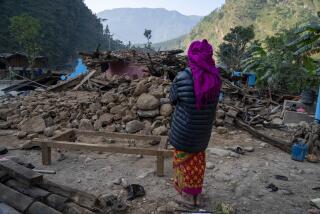Economic Effects of India’s Quake Believed Limited
AHMADABAD, India — India’s earthquake had the potential to knock the country’s economy back into the Stone Age, striking in a region that refines 55% of India’s petroleum products and makes 45% of its pharmaceuticals.
The state of Gujarat, about the size of Nebraska, and its proverbially entrepreneurial 41 million people also manufacture a large share of India’s textiles and cut and polished diamonds, which account for about a third of the nation’s total exports. And Gujarat is home to India’s most important port, Kandla, which handles 15% of the nation’s maritime cargo.
The individual tragedies are widespread and profound. About 50,000 artisans in the area called Kutch, where the quake was most lethal, used to earn their livelihood making tie-dyed clothing and other handicrafts worth nearly $9 million.
Many died in the Jan. 26 quake, and an unknown number of survivors saw their hand looms and other equipment entombed in rubble with the rest of their belongings.
But in terms of economic ripple effects, the quake, by striking inhabitants who largely live from handicrafts, fishing and salt making, was limited. And the most important industrial structures were strong enough to survive the temblor.
Most major facilities, including India’s largest refinery at Jamnagar and a 450-megawatt nuclear power station, were reportedly untouched.
“Industrial houses have not lost much, really, because their plants [in Gujarat] were new and many had looked at earthquake requirements and constructed accordingly,” said Rajiv Desai, managing director of the Ahmadabad Stock Exchange, India’s fifth largest.
India’s exploding high-technology sector, which is centered hundreds of miles away in the southern cities of Bangalore, Hyderabad and Madras, escaped largely unscathed, according to Yogesh Sharma, editor of Siliconindia, an online technology Web site based in Silicon Valley.
Hewlett-Packard Co., Intel Corp., Microsoft Corp. and other leading U.S. firms are outsourcing work in India because it offers a large pool of skilled English-speaking computer specialists.
Silicon Valley’s Indian community has raised thousands of dollars in relief for the earthquake victims. Riccardo Barbieri, senior economist for global emerging markets at Morgan Stanley Dean Witter in London, said India’s economy should take a palpable hit because of the disaster but should quickly rebound and then improve.
“Typically, production in terms of yearly gross bounces back because of the reconstruction effect,” Barbieri said. “The country is still considered as having a huge potential, if liberalization continues.”
Excluding replacement costs for property in Kutch and for about 100 multistory buildings that tumbled to the ground, Sunil R. Parekh, Gujarat director for the Confederation of Indian Industry, estimated the economic damage at the equivalent of having all of Gujarat’s factories work at only 50% of output for 15 to 20 days.
That would represent a loss of $2.2 billion--considerable in a land where many live on less than a dollar a day but modest when factored into India’s annual gross domestic product of about $500 billion.
That factories are intact, however, doesn’t mean assembly lines can or will resume soon. The quake also triggered an exodus of panicked migrant laborers, and luring them back or replacing them may take weeks, if not months.
This variable could multiply and prolong the quake’s economic impact--on the diamond-cutting center of Surat, for example, where employees deserted in droves.
“It will take at least 15 days to resume production by major industries which had shut down after the devastating earthquake and subsequent migration of workers,” Indian Textiles Minister Kashiram Rana told reporters in New Delhi over the weekend.
If output is not back at pre-quake levels by January’s end, predicted Rana, who represents Gujarat in the national parliament, the loss to India could top $5.5 billion. That is more than twice Parekh’s estimate.
According to Desai, half of the 5,000 people who work in the Ahmadabad Stock Exchange, brokerages or other related businesses have moved out of the multistory buildings where they used to live and are sleeping in restaurants, parks, cars or other places as aftershocks continue.
“The fear has not totally disappeared,” Desai said.
But the Ahmadabad exchange, India’s second oldest, was open for business the Monday following the Friday quake, and daily turnover returned in three days to the normal $77.7 million.
At Kandla, on the Gulf of Kutch, three of the port’s eight berths were open again by Saturday. But the economic disruption has been considerable. More than 25,000 tons of grain and soy oil are reportedly held up and could rot, and more than a dozen ships were lined up at last report waiting to dock.
More to Read
Sign up for Essential California
The most important California stories and recommendations in your inbox every morning.
You may occasionally receive promotional content from the Los Angeles Times.










